August 19, 2013
By Gordana Liddell
BURLINGTON, ON. Whenever I walk through a forest, I try and picture what it used to be like when only the indigenous people were here. I look for arrowheads, (never with any luck), and I always try and just take in the sounds and smells around me. Those things have not changed, so it must have sounded and smelled the same to them. The actual place is still the same place.
When it comes to Alton Village, walking through the neighbourhoods, with freshly paved sidewalks and nicely manicured lawns, cars drive by and the dogs are on leashes. I would wager a healthy bet that not too many people have ever wondered what this area was like pre-construction. One of the reasons being that many of us know what it was like. A big empty field, or former farmland. Nothing more and nothing less. Much like what we would see driving while along Dundas St west of town…for now, that is.
Well the truth is that Alton, like most places, does have a history.
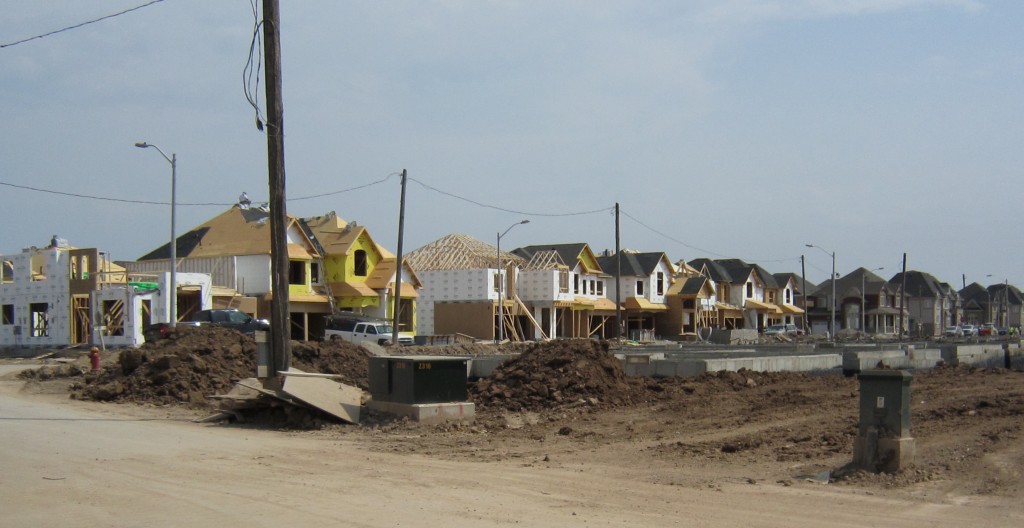
Even in their wildest imaginations – the Alton family would never have thought those farm fields would look like this – imagine the increase in value.
Now, I really need to preface this article by stating that it was very difficult to put together the dates and names and to make perfect sense of the information that I found. Nearly every historian that I spoke with, every library book that I looked at, (yes…actual books. Google couldn’t get it done, but when doing research on pioneers it seems fitting to do stuff the old-fashioned way, wouldn’t you say?), the archives from the history room…nothing I found corresponded with anything else I found. Nevertheless, I will present to you the facts as I was best able to determine them.
Let’s begin with John Cleaver. The land that Alton Village sits on was originally owned by John Cleaver who, along with his wife Mary, arrived in Canada in 1805 from Pennsylvania. It’s unclear as to why they came to Canada but given the year, many resources come to the conclusion that it was quite possibly due to post American Revolution unrest.
In 1806, Nelson Township, (what most of us today call “Burlington”), held a land lottery and Mr. Cleaver drew the lot that Alton Village now rests on. He was awarded the 200 acres from the areas that are now called Dundas St. to Walker’s Line to No.1 Sideroad.
Subsequently, John Cleaver brought his bride to the area, and he built their matrimonial home; a log cabin, undoubtedly with a good threshold over which to carry her. (I think it was a requirement in those days. ) The Cleavers settled there and began their family. One of their daughters was named Charlotte and this is the girl who caught the eye of one Thomas Alton.
Thomas Alton was a young lad from the area of Appleby, in Westmoreland County, England. In fact, many of the original families in Nelson Township came from there. (For reference, this area is in the Northeast part of England, about 100 kms north of Manchester.) Thomas was born in 1795 and immigrated to Nelson Township in 1819. I did the math for you…he was 24. Like many of our grandparents, parents, or even our generation of immigrants, he came across the ocean with very little, only 75 English Pounds to his name. I can’t imagine what that amount translated into 200 years ago…but I would venture a guess that it was not a tremendous amount.
Now come all the different interpretations of young Thomas’ venture…
Thomas Alton settled in Nelson Township, where he rented out 40 acres of land for 4 years.
or…He bought land at the rate of 1 Pound per acre on the north side of the “Middle Road”, which is now the QEW, the second lot west of Appleby Line.
Or…He applied for a crown grant in which essentially, the crown, (the governing body), transfers ownership of the property of the piece of land, turning it from public to private property. In order to get a grant, and to keep it, certain conditions had to be met in order to receive the title. A specific amount of the land had to be cultivated, the applicant must live on the property, and a homestead had to be built on the property. He was first granted the land on the north side of the Middle Road, the second lot west of Appleby. He continued to farm it and acquire more land until he owned 1250 acres.
Then he met the lovely Charlotte. And in 1822, Thomas Alton married Charlotte Cleaver.
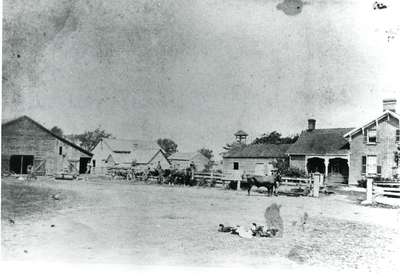
The Altons built a house that has stood the test of time. The basic structure seen here still comes through loud and clear in the structure that stands on what is now called Settlement Court
It is said that Mr. and Mrs. Alton “acquired” the land that is now Alton Village in 1830 from Charlotte’s father, John Cleaver. And they subsequently built a brick house, (which used to have a Dundas Street address, but now graces the modern-day street of Settlement Court). Different records show the brick house being built in 1837 as well as circa 1860. Let’s just say it was built in the mid 1800’s.
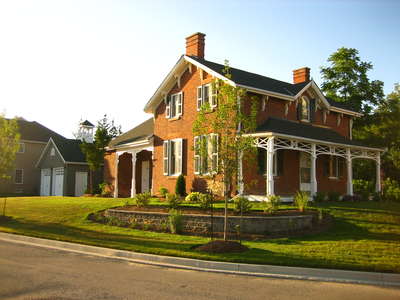
Beautifully and faithfully restored – the Alton house is now tucked away in a part of the Alton village,
And as the family grew in size over the years, so did the house, as well as the number of outbuildings on their farm including, a barn, garage and sheds.
Based on the different sources, all evidence seems to point to some of the same conclusions.
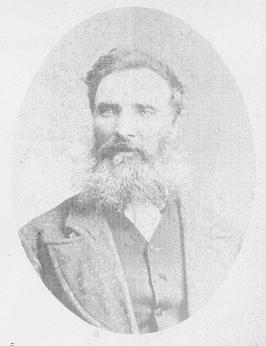
Not a lot of pictures in the early days. The Alton-Cleaver marriage is said to have produced 16 children – might have been 17, one of whom was David who married Mary Ann Breckon on February 2, 1854
The one consistent thing that I did read about Thomas Alton was that he was a hard worker and an industrious man. Essentially, he came to the area, “got” some land north of the Middle Road, increased the land’s value and bought more, and he made it work.
So, at some point, we think that Thomas and Charlotte are living on their farm which is now Alton Village. (I say at some point because the years 1822 to 1830 remain unaccounted for). They had 16 kids, (some sources say 17), and that’s a whole lotta branches on the tree, but it wasn’t unusual for the time. One son was named Joseph. He married his bride Hannah, and this couple lived on the famed homestead from the 1850’s. The Alton descendants continued to live there well into the 20th century. Joseph and Hannah had a son named Thomas…was this the Thomas that is referred to; that the area and the street are named after? Did his granddaddy ever even live on this property? One source tells me that even this is uncertain. (If it means anything, I personally think Thomas Sr. did live there, as most evidence suggests so).
One of the most interesting stories I dug up was that the Alton homestead is part of a legend. In 1837, while William Lyon Mackenzie King was seeking refuge during the Upper Canada Rebellion, one of the homes to take him in was the Alton home. They helped to feed, clothe and hide him, and they disguised him and gave him horses so that he could keep right on going. The Alton and Cleaver men were said to have met up with a party of Tories in search of Mackenzie and they held them off at gunpoint and forced them off of their property. Mackenzie eventually made it to the American border and sought refuge there for a while.
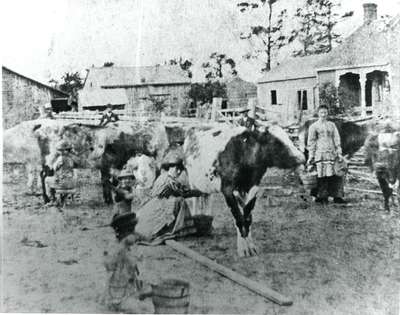
Frontier or not – they still had to eat and milk was a big staple in most diet – the cows just stood there while the woman milked them. The house as it stands today is clearly seen in the background.
It may be the suburban suburbs now, but it really was quite the frontier land, complete with shootouts and outlaws.
Frontier it was, and it was very hard to get around. The area of Appleby, current day Alton Village, was pretty isolated, and the population was very sparse. Believe it or not, the best time of the year to get around was in the winter when the snow was packed hard and it made driving a carriage possible, otherwise the roads were very tough to drive on. Then, in 1847 (again, that year is a sketchy detail), the Great Western Railroad had reached the area. Now people had access to Niagara Falls, Hamilton, London, Windsor, all now because of the train. Things began to change then, as they tend to do when a train rolls through.
The land was eventually handed down, not to a family member, but to a beloved farm hand that went by the name of Richardson. When was it handed down and why to a farm hand? I don’t know. But I do know that the person who sold the land was not named Alton…or Cleaver.
Enter the development of modern-day Alton, starting with the catalyst which was highway 407.

The Mike Harris government gave the province the 407 highway then sold it to an Italian firm who now have the ability to take your license away from you if there is a dispute over the payment of a toll road charge. On the upside – the highway did allow for the creation of the Alton Village we have today.
The 407 was planned back in 1972, began construction in 1987 and opened in 1997 from the 410 to the 404. In 1998, the part of the 407 that borders Alton today, (the Winston Churchill to the 403 segment) was built. The land needed for this 407 extension was purchased from Mr. Richardson for $50 million.(Nice.)
And so it followed that when the 407 was built, the area between Dundas to the 407 was no longer a naturally rural area…and the urban border got moved north. So, in 2004, developers then bought up this remaining land form Mr. Richardson for $20 million. They got their permits, and in 2006, the development of our beloved Alton Village began.
Today that house, that one and a half story piece of history, sits atop its own little hill, right within our own subdivision, on the suitably named Settlement Court. It’s a living testament to our history and the fact that there is a story that preceded all of this construction.
It has been beautifully preserved and restored and in 2007 it was designated a heritage building. I was lucky enough to be invited into the home. The gracious owner showed me around and pointed out the numerous original elements, and it was obvious that painstaking care and hard work had been taken in order to preserve the integrity of the property. It is a museum within our neighbourhood.
I was told that between the years 2007-2009, Mattamy sold the house to an employee in his early 20’s. This man obviously knew what a gift it was and took great care to restore it, and in 2009 he sold it to the current owners. Luckily for all of us, both the previous as well as the current owners have treated the house in the special way that it deserves, also with a sense of obligation to its history.
Upon entering the home, I was struck by all of the beautiful wood. All of the original floors, trim and doors have been preserved beautifully. The rooms are currently being used as they were originally intended and it’s easy to let your imagination go and feel what life was like in this house so many years ago.
Once in the front door, you are standing in the hearth area, the dining room, which leads to the kitchen. From this one room, two staircases lead the way upstairs, originally one way for the family, and the other for the maids. Some details you would not see today are a field stone foundation, a cellar door with a trapdoor leading outside, 150 year old doors and hardware, a beautifully ornate doorbell, and a bell on top of the house. The architectural work on the outside of the house are period, such as the gable and the porch details, and help to make the house stand out in a subtle way. Oh…and there’s that triple sized lot with the creek running behind it…that stands out, too.
The owners were looking for a character home, and boy did they bag a good one. For both the interior and the exterior to be maintained in the period, and within that character, shows a great deal of caring. It blends in…somewhat…but it still stands out. It’s not that obvious at first glance, but when you drive by, that sideways facing house catches your attention.
The Cleaver-then-Alton homestead is an important historical gem to us. The property and the people who lived in it, played a significant role in the settlement of Nelson township, and subsequently, Alton Village.
The Cleaver’s also had a great deal to do with the history of this land. It was, after all, originally Cleaver land. Well, it was originally Aboriginal land, then crown land, then…well, that’s the type of argument that starts wars.
The fact is that when the original families immigrated to the area, they all had large families and, the sparse population being a factor, they intermarried. The Alton’s and the Cleaver families were both large, powerful and prominent. And they were both a part of Alton Village history.
Just as every person has a story, I believe that every place has a story.
The details of “who” and “when” remain unclear…mysterious even. Like a woman who doesn’t reveal everything about herself, including her age, there is a certain mystique about her…she “keeps them guessing”. The same holds true for the history of an area. Not knowing absolutely everything lends itself to infinite possibilities. It lets our imaginations add colour and our own details. It’s more interesting that way…because it keeps them guessing.
All the historical pictures are from the Burlington Historical Society digital archives.
 Gordana Liddell is a writer. Her passion is travel. We were able to convince her to travel about the community that first got her to Burlington and to focus on where she and her husband decided to settle.
Gordana Liddell is a writer. Her passion is travel. We were able to convince her to travel about the community that first got her to Burlington and to focus on where she and her husband decided to settle.



















My husband was doing some landscaping today and came across a horseshoe! We think it’s pretty neat to possibly have a piece of history.
Hello Ms Liddell,
Thomas Alton, b 8 March 1795, Appleby,Westmorland, d Nelson Township,21 Feb 1872, is my second cousin, 6x removed. His father, David Alton, moved from Muker,Swaledale, Yorkshire to Appleby which was actually not too far away.
The elder brother of Charlotte Cleaver, James Cleaver, owned the Lowville Mill, along with his son in law David Plewes.
The Lowville Mill is currently a City of Burlington Heritage House.
I have the Alton,Cleaver,Plewes genealogy on my website
Wow,
Very interesting. Thanks for doing the research on that.
I opened Alton Dental (in Alton Village) 6 years ago. At that time construction had barely started. I could have bought a modest home for $299,000. In retrospect, I should have bought several.
I never knew the history of Alton Village. Thanks for sharing.
drdave
This is fantastic, my kids are going too be so excited to hear this story. The love history stories and now one about their own neighborhood is going to knock their socks off. Thank you so much for this gift !
Excellent article, thank you for writing it!
Very interesting read. Being a resident of the community, I had no knowledge of the history behind the name. I’m glad that some thought went in to deciding the name of the community.
Now if only I can find someone to put the same effort into slowing down traffic on my street!!
Leave that for another day.
Well written story.
Outstanding piece, Ms. Liddell!
Please consider checking out the historic “Zimmerman Village” (a mile north of the 407 on Appleby Line) during your travels around Burlington. We’d truly benefit from your exploration of this community as well!
Great article,interesting to read .
Great Piece!
I just had to check as I remember a Sherlock Holmes story where Watson exclaims that “…why 100 pounds is a gentleman’s income!” So 240 Pence to a Pound in the pre decimal days of Britain, & from an internet search – a farm labourer made between 20 – 35 pence a day, so one Pound – ten days wages, & Mr Alton had 75£ two years wages when he arrived. I do remember from history that there was quite a lot of civil unrest after the Napoleonanic wars especially so in and around Manchester. According to Wikipedia there was something called The Peterloo Massacre in 1819. With that kind of money, and where he was from I wonder if Mr Alton had to get out of town… guess we’ll never know.
Please write more. This was interesting and I had no idea this was in the midst of a modern community.